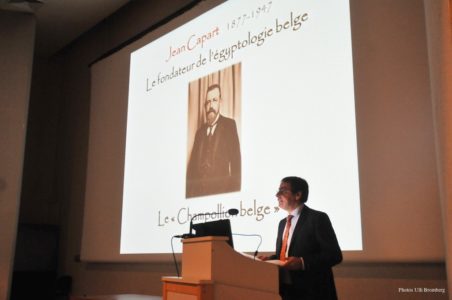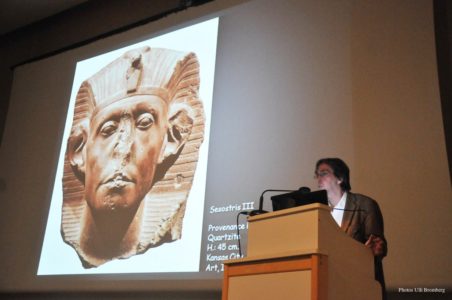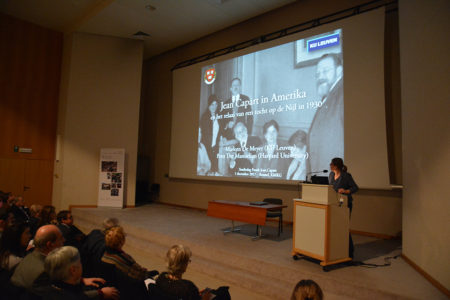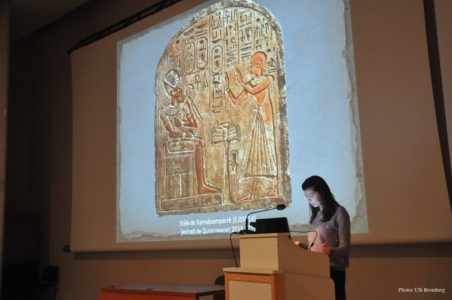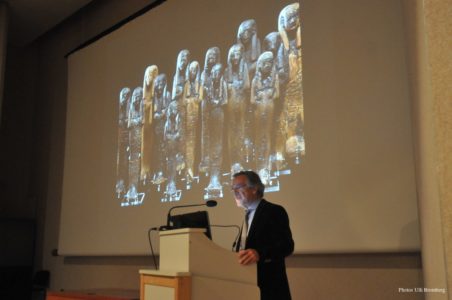When I first heard the name of Jean Capart in 1977, I was far from being able to imagine the role that the founder of Egyptology in Belgium would come to play in my life and even further from suspecting that, forty years later, I would be invited to welcome visitors to a website entirely devoted to his life and work.
I was just twelve years old when my parents took me to the Palais des Beaux-Arts in Brussels to see an exhibition entitled Egypte éternelle. Chefs-d’œuvre du Brooklyn Museum (Eternal Egypt. Masterpieces from the Brooklyn Museum). The event was a good way of celebrating the bi-centenary of the founding of the USA as well as the centenary of Jean Capart’s birth. Sometimes called the Belgian Champollion, Capart’s brilliant career spanned half a century (1897-1947) and included working as Director of the Queen Elisabeth Egyptology Foundation (QEEF), Curator-in-Chief of the Royal Museums of Art and History (the Cinquantenaire Museum), Advisory Curator at the Brooklyn Museum of New York, university professor, writer, publisher and lecturer. Yet, from my visit to the exhibition, the only things I remembered about Jean Capart were his name and appearance. With his beard and bow-tie, he looked like a character straight out of a comic book! And this was not far from the truth, albeit somewhat in reverse, because he provided the inspiration for both Hergé and Edgar-P. Jacobs for two of their fictional characters, respectively Professeur Bergamotte (in Tintin and the 7 Crystal Balls) and Docteur Grossgrabenstein (in Blake and Mortimer. The Mystery of the Great Pyramid).
Over the next twenty years I had little reason to think about Jean Capart but then in 1977, by which time I had become a historian, he re-surfaced in my life. I was searching for documentation about Capart and could hardly believe what I found: there was hardly anything written about him, except for a somewhat hagiographic biography published in 1974 by two members of his family and two art history theses, which did not mention his career as an Egyptologist. This seemed to me to be rather “lightweight”, given that Capart was one of the major figures of Belgian science in the 20th century. Far from discouraging me, this great lacuna instead incited me to undertake the writing of his biography myself. My aim was to enable the general public to (re-)discover the man who had previously been known and widely appreciated not only by scholars but also by the general public. Jean Capart adored Egypt, but his humanism was never totally buried in the sands of the Egyptian desert. He was a man who once said about himself: “It is said that if you want to boast about having lived a great life, you must have had children, written a book and built a house. Well, I have ten children, I have written a library shelf full of books and I have built a museum.” Words that lack a certain modesty to be sure, but are nevertheless deserved.
Increasingly intrigued by Jean Capart’s personality and the history of Egyptology in Belgium, which he alone seemed to embody, I tried to find the last witnesses to an age that I felt was a truly golden age. On 19 June 1997, the 50th anniversary of Jean Capart’s death, I met his grand-daughter, Alix Brancart-Capart, and several other members his family who were present at the inauguration of the Jean Capart Pyramid in Woluwe – Saint- Pierre, the Brussels commune where he had lived. A few days later, I was invited to meet Arpag Mekhitarian, Honorary Secretary General of the Queen Elisabeth Egyptology Foundation. Doyen of Belgian Egyptology and already 86 years old, he gave me such a warm welcome and we soon became friends. He gave me an introduction to Luc Limme, Curator of the Egyptology section at the Cinquantenaire Museum, as well as to a number of talented and enthusiastic archaeologists and art historians. Among these were Florence Doyen (Managing Director of the Egyptologica Association), Luc Delvaux (the current curator of the dynastic Egypt and Greco-Roman section at the RMAH) and Eugène Warmenbol (a specialist in the pre-history of Belgian Egyptology and prehistory in general). Between 1997 and the death of Arpag Mekhitarian in 2004, I spent many long, delicious afternoons at the Cinquantenaire and elsewhere, listening to Arpag Mekhitarian recount his memories of Jean Capart, who had told him that he considered Arpag as his “11th child” and “the confidant for (his) Egyptologist thoughts”. Having being handed such a legacy, I also began to explore the extensive archives of the Queen Elisabeth Egyptology Foundation (re-named the Queen Elisabeth Egyptology Association in 2004). Most of these archives were unpublished and so I was immediately struck by their historical interest, but sadly also by their poor condition and their almost total inaccessibility to researchers (with the exception of a few privileged people such as myself).
Patiently working in the QEEF’s archives as well as in the institutional archives of the RMAH, the Royal Palace of Brussels, the Belgian Ministry of Foreign Affairs and other institutions enabled me to publish my first articles and to deliver my first lectures about Jean Capart. However, despite a promising beginning, it soon became apparent that a few hours of voluntary work here and there would be totally insufficient to get to grips with the huge documentary windfall to which I now had access. In 2012, I was invited to Egypt by the Supreme Council of Antiquities to talk about the first Belgian excavations in Egypt and whilst I was there, Laurent Bavay (now Director of the Institut Français d’Archéologie Orientale, Cairo) suggested that I apply for a scientific mandate that would enable me to devote the time needed for my work. A project was drawn up on paper and this received support from a number of eminent Egyptologists, archaeologists and historians. I applied to a university for a mandate from the Fonds Spécial de Recherche (Special Research Fund) but, unfortunately, this was not accepted.
The project was re-launched in 2015, when Dominique Capart, Jean Capart’s oldest grandson, shared with me his desire to make a practical contribution to safeguarding and promoting the historic heritage of the man who had founded Belgian Egyptology. Blessed with an energy and savoir-faire reminiscent of his grandfather, Dominique and his brother Gilles set up the Jean Capart Fund, a private fund. In 2016, under the direction of Dominique Allard, the King Baudouin Foundation, a public utility foundation that is well known both in Belgium and abroad, accepted to host the fund and put its running in the expert hands of Anne De Breuck and Charlotte Hoschet. This fund has very clear objectives, laid out in its statutes:
The objective of the Fund is to promote the historical heritage of the Belgian Egyptologist Jean Capart with a view to nurturing both the historical and scientific aspects of Egyptology in Belgium. The Fund will support the scientific work of identification, collection, sorting, conservation, drawing up of inventories and digitization of Jean Capart’s archives as well as promoting their existence. The Fund can support any initiative of research or publication relating to Jean Capart and his work, including an Internet site and any other means of communication. As a general rule it will undertake or support any initiative that corresponds to its objective. The Fund collaborates with the not for profit Queen Elisabeth Egyptology Association, whose headquarters are at the Royal Museums of Art and History in Brussels. As a priority, the Fund will finance, alone or together with other institutions or universities, the work of a scientist who has been appointed to coordinate a project whose subject matter relates to the Fund’s objective, such as the project submitted by Jean-Michel Bruffaerts during the preparatory phase of setting up the Fund. In order to pursue its objectives, the Fund collects financial contributions from patrons who are then associated with the work undertaken.
From the moment the Jean Capart Fund was set up, a Management Committee was established, tasked with ensuring the proper use of its funds, as well as a Committee of Experts that would oversee the scientific coherence of the project. The current members of the Committee of Experts are Laurent Bavay (ULB/IFAO), Eric Bousmar (USL-B), Jean-Michel Bruffaerts (FJC/RMAH), Wouter Claes (RMAH), Marleen De Meyer (KULeuven), Luc Limme (AERE), Alain Martin (AERE), Nathalie Tousignant (USL-B) and Eugène Warmenbol (ULB). Her Royal Highness Princess Esmeralda of Belgium graciously accepted to be Honorary President of the Fund, as a mark of recognition of the shared interests enjoyed by her grandmother Queen Elisabeth and her father King Leopold III and Jean Capart and his family.
“My purpose is to teach others what I have had the joy of knowing myself.” These few words, uttered by Jean Capart, could be the motto for this website. They will in any case be a source of inspiration for all those who visit the website with a desire to expand their knowledge. At the present time, the website is still under development, so this is really a point of departure. It can nevertheless be considered as the first practical result of the Jean Capart Fund. Its form owes much to the creativity and knowledge of Philippe Capart, Jean Capart’s great grandson and his colleagues: André Moons (Séraphine Graphics) and Denis Capart, the family genealogist. The content of the website will be expanded as our work progresses and in function of the support for our work provided by our patrons.
All of the friends of the Jean Capart Fund, whether they are part of the basic team or simply donors to the project, work in their own way and according to their means to complete the Capart project. I should perhaps add that in 1921, the French Jesuit Camille Lagier wrote to Jean Capart: “The charitable Egyptian lives again through you. One day, like Hirkhouf’s passenger, I found myself on the bank of the river to be crossed, but without even the smallest boat. But you were there, with your beautiful Egyptian felucca. You held out your hand and invited me aboard. Under your flag, I was able to reach the opposite bank.”
We have not yet reached the opposite bank, but it is in sight. Jean Capart liked to remind us that, according to Herodotus, the Pharaoh Kheops needed 20 years and 100,000 men to build his famous pyramid. Let’s hope that with the help of our donors, both large and small, it will not take us 20 more years to reach our objectives and to make this website a reference for Jean Capart and the history of Belgian Egyptology.

